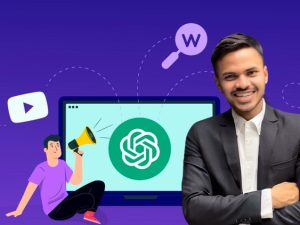7 Days of Hands-On AI Development Bootcamp and Certification
- Description
- Curriculum
- FAQ
- Reviews
“Welcome to “”7 Days of Hands-On AI Development Bootcamp: Build Real-World AI Projects from Scratch,”” a course designed for absolute beginners who are eager to step into the world of artificial intelligence (AI). This course is ideal for those with little to no prior experience in programming or AI but have the curiosity and drive to learn. Whether you’re a student, a career-changer, or simply interested in building your first AI project, this course is structured to take you from zero knowledge to deploying real-world AI models.Over the span of 7 days, you’ll build projects every day, starting from the basics of Python programming to deploying a fully-functional AI model on the web. Each day is packed with hands-on projects, practical applications, and easy-to-follow instructions to ensure that you gain not just theoretical knowledge but real-world skills that you can apply right away.What You Will Learn:This course covers everything you need to get started with AI development. Each day is focused on a new topic, gradually building on what you’ve learned previously. Here’s a brief overview of what you can expect:Day 1: Python for AI BasicsWe start with the foundation-Python programming. Python is the most popular language for AI, and by the end of Day 1, you’ll understand basic Python syntax, data types, control flow, and how to use essential libraries like NumPy and Pandas. You’ll also build your first simple program, setting the stage for the AI projects to come.Day 2: Exploratory Data Analysis (EDA)Data is the backbone of AI, and before you can train models, you need to know how to analyze it. On Day 2, you will learn how to clean, manipulate, and visualize data. Using libraries like Matplotlib and Seaborn, you’ll explore datasets, handle missing data, and visualize relationships between different features. You’ll work with real-world data to uncover hidden insights.Day 3: Introduction to Machine LearningOn Day 3, we dive into machine learning with a focus on Linear Regression. You’ll learn the fundamentals of supervised learning, including how to split your dataset into training and testing sets, train a model, and evaluate its performance. By the end of the day, you’ll build your first predictive model to forecast continuous variables like house prices.Day 4: Classification Models in Machine LearningNext, you’ll tackle classification problems using Logistic Regression. Whether predicting if an email is spam or classifying customer churn, this day teaches you how to build a classification model and evaluate it using metrics like precision, recall, and accuracy. You’ll also learn how to interpret confusion matrices to understand the performance of your model.Day 5: Neural Networks and Deep LearningDay 5 introduces the fascinating world of neural networks. You’ll build a simple feedforward neural network to classify handwritten digits using the MNIST dataset. You’ll gain hands-on experience with libraries like TensorFlow or PyTorch, and learn about key concepts such as activation functions, backpropagation, and training deep learning models.Day 6: Natural Language Processing (NLP)Day 6 focuses on Natural Language Processing (NLP), where you’ll build a sentiment analysis model using text data. By leveraging pre-trained models from Hugging Face or building your own with TensorFlow, you’ll classify text as positive or negative. This day provides an introduction to text preprocessing, tokenization, and transfer learning in NLP.Day 7: Deploying an AI Model as a Web ServiceOn the final day, you’ll learn how to deploy your AI models as a web service using Flask. You’ll integrate your AI models into a web application, making them accessible to users via a browser. Additionally, you’ll deploy your app to a cloud platform like Heroku. By the end of the day, you’ll have a working AI-powered web app that anyone can interact with online.Who This Course is For:Absolute Beginners: No prior programming or AI knowledge is required. This course is designed to be beginner-friendly.Students: If you’re studying AI, machine learning, or data science, this course will give you the practical hands-on experience to solidify your learning.Career-Changers: If you’re looking to switch to a career in AI or machine learning, this course will give you the foundation to start your journey.Hobbyists and Enthusiasts: If you’re simply curious about AI and want to build projects for fun, this course will provide you with easy-to-follow instructions.Why Take This Course?This course is not just about theory-it’s about building. You’ll have real projects in your portfolio by the end of the week. Each day is packed with practical coding exercises and project-building that makes learning AI development easy and approachable. Whether you want to boost your career, impress employers, or explore the world of AI for personal interest, this course is designed to make that journey engaging, interactive, and rewarding.So, are you ready to build AI projects from scratch in just 7 days? Let’s get started!”
-
2Introduction to Day 1: Python for AI BasicsVideo lesson
-
3Introduction to Python ProgrammingVideo lesson
-
4Python BasicsVideo lesson
-
5Working with Lists and DictionariesVideo lesson
-
6Introduction to NumPyVideo lesson
-
7Introduction to PandasVideo lesson
-
8Hands-on Project: Basic Data Manipulation and File HandlingVideo lesson
-
9Day 1: Coding ExerciseText lesson
-
10Introduction to Day 2: Exploratory Data Analysis (EDA)Video lesson
-
11Loading and Inspecting DataVideo lesson
-
12Handling Missing DataVideo lesson
-
13Data Transformation and Feature EngineeringVideo lesson
-
14Visualizing Data with Matplotlib and SeabornVideo lesson
-
15Descriptive StatisticsVideo lesson
-
16Hands-on Project: Exploratory Data Analysis on a Real DatasetVideo lesson
-
17Day 2: Coding ExerciseText lesson
-
18Introduction to Day 3: Introduction to Machine Learning (ML)Video lesson
-
19What is Machine Learning?Video lesson
-
20Supervised Learning and Dataset PreparationVideo lesson
-
21Building a Linear Regression ModelVideo lesson
-
22Evaluating the ModelVideo lesson
-
23Feature Scaling and RegularizationVideo lesson
-
24Hands-on Project: Predicting House Prices using Linear RegressionVideo lesson
-
25Day 3: Coding ExerciseText lesson
-
26Introduction to Day 4: Classification Models in Machine LearningVideo lesson
-
27What is Classification?Video lesson
-
28Logistic Regression for ClassificationVideo lesson
-
29Building a Logistic Regression ClassifierVideo lesson
-
30Evaluating the Classification ModelVideo lesson
-
31Visualizing the Decision BoundaryVideo lesson
-
32Hands-on Project: Spam Detection Using Logistic RegressionVideo lesson
-
33Day 4: Coding ExerciseText lesson
-
34Introduction to Day 5: Introduction to Neural Networks and Deep LearningVideo lesson
-
35What is a Neural Network?Video lesson
-
36Introduction to Deep Learning FrameworksVideo lesson
-
37MNIST Dataset OverviewVideo lesson
-
38Building a Simple Neural Network for MNIST ClassificationVideo lesson
-
39Evaluating the Neural NetworkVideo lesson
-
40Understanding Activation FunctionsVideo lesson
-
41Hands-on Project: Handwritten Digit Classification using Neural NetworksVideo lesson
-
42Day 5: Coding ExerciseText lesson
-
43Introduction to Day 6: Building a Sentiment Analysis Model Using NLPVideo lesson
-
44Introduction to Natural Language Processing (NLP)Video lesson
-
45Sentiment Analysis: Understanding Text ClassificationVideo lesson
-
46Text PreprocessingVideo lesson
-
47Using Pre-trained Models for NLP (Hugging Face)Video lesson
-
48Building a Sentiment Analysis Model with TensorFlowVideo lesson
-
49Evaluating the ModelVideo lesson
-
50Hands-on Project: Sentiment Analysis Using Pre-trained NLP ModelsVideo lesson
-
51Day 6: Coding ExerciseText lesson

External Links May Contain Affiliate Links read more





